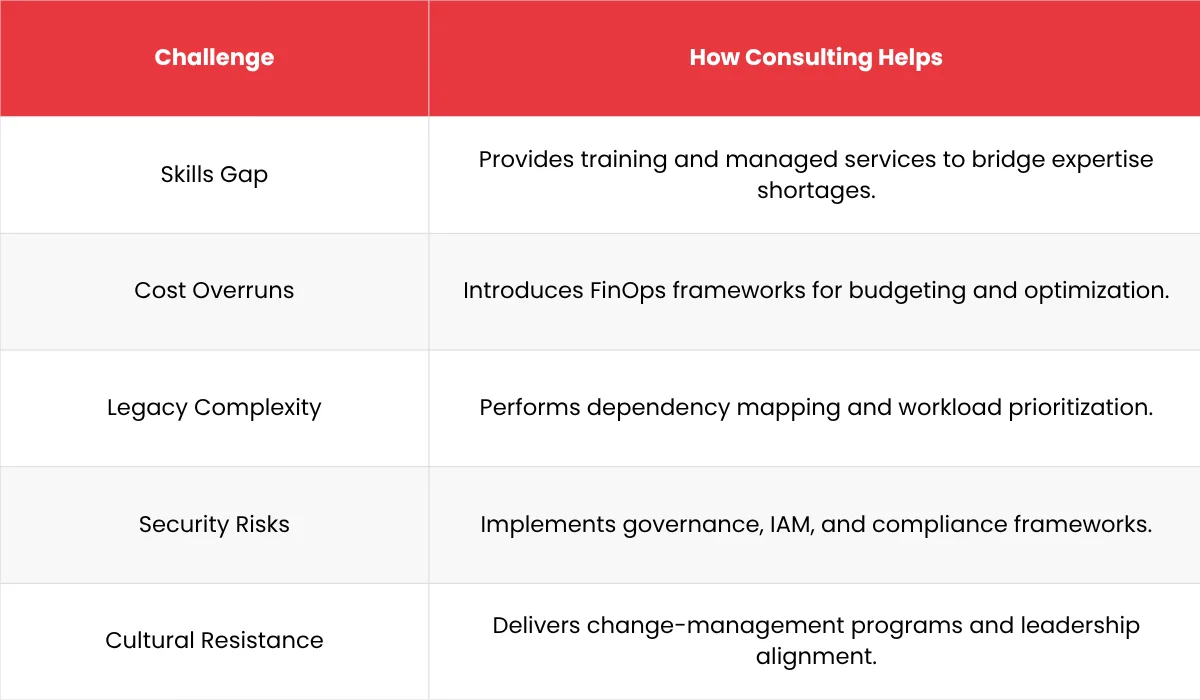Are you struggling to make the most of the cloud for your business? Moving to the cloud can improve efficiency, reduce costs, and make your operations more flexible, but getting it right isn’t always easy. Many businesses face challenges like rising costs, security concerns, and slow adoption of new technologies.
Hire top cloud consultants. They guide you step by step, from planning your cloud strategy to migrating applications and optimizing operations, so you can get real results without the guesswork.
In this post, you’ll learn why you must take cloud transformation consulting, proven practices for this successful shift, and examples of businesses that have solved common cloud challenges with expert guidance.
What is Cloud Transformation Consulting?
Cloud transformation consulting is a structured approach to planning, implementing, and optimizing an organization’s journey to the cloud. Unlike one-off “lift-and-shift” migrations, it encompasses the full modernization lifecycle, from infrastructure and applications to culture and processes.
It helps organizations “assess, plan, migrate, manage, and optimize” their cloud environments. It’s not just about technology; it’s about aligning cloud strategy with business objectives, whether that’s increasing agility, reducing costs, improving security, or enabling innovation.
Cloud consultants bring deep expertise in cloud platforms (AWS, Azure, Google Cloud, etc.), governance frameworks, and best practices. They help enterprises avoid common pitfalls such as cost overruns, misconfigurations, and downtime, ensuring transformation delivers measurable outcomes.
Why Do You Need Cloud Transformation Consulting

Why are so many enterprises partnering with cloud consultants instead of going it alone? Let’s look at the tangible benefits.
1. Cost Efficiency and Optimization
One of the most immediate advantages of cloud transformation is cost efficiency. By moving from capital-intensive on-premises systems to flexible, pay-as-you-go models, businesses can reduce infrastructure expenses and scale resources based on demand.
However, without expert guidance, cloud costs can spiral. Research shows that wasted cloud spend is a persistent issue, often caused by idle resources or over-provisioning. Cloud consultants implement FinOps practices (financial operations for cloud) to track, analyze, and optimize usage.
For example, a marketing consultancy saved nearly $50,000 annually and achieved a 60% improvement in agility after migrating to AWS with professional consulting support.
The takeaway? Cloud transformation consulting turns potential cost savings into sustained financial performance through governance, automation, and continuous optimization.
2. Agility, Scalability, and Performance
In a market where customer demands change rapidly, business agility is essential. Cloud environments enable elastic scaling, allowing organizations to instantly adjust resources to meet workload fluctuations, something traditional data centers can’t match.
Cloud consultants design resilient architectures optimized for performance and scalability. By introducing automation, microservices, and containerization, they help enterprises deploy applications faster, recover quickly from failures, and handle peak loads efficiently.
Businesses leveraging cloud transformation strategies experience faster innovation cycles, improved collaboration, and reduced time-to-market. Consulting accelerates this process by ensuring the right tools, frameworks, and processes are in place from day one.
3. Security and Compliance by Design
Security remains one of the biggest concerns during cloud transformation, and rightly so. Misconfigurations, access control issues, and compliance gaps can expose organizations to significant risks.
A robust cloud transformation consulting engagement embeds security-by-design, ensuring every workload is compliant with relevant regulations such as GDPR, HIPAA, or ISO 27001. Consultants help establish identity and access management (IAM) frameworks, encryption standards, and continuous monitoring systems.
For example, we helped a fintech company migrate their Windows-based infrastructure to AWS and set up automated backups, monitoring, and security policies. As a result, they achieved 99.99% uptime, cut audit preparation time by 40%, and reduced compliance risk by 75%.
4. Driving Innovation and Business Transformation
Businesses that go “all-in” on cloud and modernize their operations achieve greater agility, outperform competitors, and unlock new business models.
Consultants play a key role here, helping organizations move beyond migration to modernization, refactoring legacy applications into microservices, adopting serverless architectures, and integrating AI and analytics capabilities. This enables faster experimentation, innovation, and data-driven decision-making.
5. Workforce Enablement and Change Management
Technology alone doesn’t guarantee transformation success. People do. The cloud introduces new ways of working, DevOps, automation, agile delivery, that require reskilling and cultural adaptation. Yet, 44% of organizations report that finding qualified cloud professionals is a top challenge (Intelliworx).
Cloud and DevOps consultants help bridge this gap through training, knowledge transfer, and change management programs. They ensure teams understand new processes, governance rules, and tools, minimizing disruption and accelerating adoption.
The result? Empowered teams who can sustain cloud success long after the consulting engagement ends.
Best Practices for Successful Cloud Transformation

Not all cloud transformations succeed. According to Gartner, more than half of cloud migrations exceed budget or timeline expectations.To maximize ROI, organizations should follow proven best practices, many of which cloud transformation consultants champion.
1. Start with a Clear Cloud Strategy
Before migrating a single workload, define a cloud strategy aligned with business goals. What outcomes are you targeting, cost savings, agility, resilience, innovation? What workloads are suitable for cloud, and which should remain on-premises or hybrid?
A well-defined strategy helps prioritize investments, minimize risk, and measure success. Consulting partners facilitate cloud readiness assessments and develop migration roadmaps that align IT transformation with enterprise strategy.
2. Choose the Right Consulting Partner
Your consulting partner can make or break the transformation. Look for firms with:
Certified expertise (AWS, Azure, Google Cloud)
Proven track record in your industry
Strong security and compliance capabilities
A collaborative, knowledge-sharing culture
3. Conduct Comprehensive Assessment and Planning
A structured assessment phase lays the foundation for a smooth migration. Consultants use discovery tools to analyze workloads, dependencies, and cloud fitness.
IBM Research highlights the use of analytics-driven “cloud fitness validation” to prioritize which systems to move first, identify refactoring opportunities, and plan migration waves.
Proper planning prevents disruption and ensures critical workloads maintain availability during the transition.
4. Adopt a Phased Migration and Modernization Approach
Avoid the temptation to move everything at once. A phased approach allows for early wins, iterative improvement, and risk control.
Consultants often begin with non-critical workloads (“lift-and-shift”), then gradually modernize applications using containers, microservices, and serverless computing.
This hybrid strategy delivers immediate value while laying the groundwork for deeper transformation.
5. Prioritize Governance, Security, and Compliance
Governance isn’t optional, it’s the backbone of sustainable cloud operations. Consultants help implement policy frameworks for cost control, access management, and workload monitoring.
Embedding security early through “security by design”. It minimizes risks and builds stakeholder confidence. Regular audits and compliance automation tools ensure continued adherence to regulations.
6. Focus on People, Culture, and Continuous Learning
Cloud transformation succeeds when people embrace change. The top cloud consulting companies not only support migration but also help in creating cloud centers of excellence (CCoE), running workshops, and fostering a culture of collaboration between IT, DevOps, and business teams.
Encouraging experimentation, agile methodologies, and ongoing learning keeps organizations adaptive in the evolving cloud landscape.
7. Commit to Continuous Optimization Post-Migration
Transformation doesn’t end once workloads are live. Continuous monitoring, cost optimization, and performance tuning are crucial to maximize ROI.
Consulting partners often introduce observability tools, automation scripts, and KPIs to track metrics such as uptime, latency, cost savings, and deployment velocity.
When moving workloads from on-premises to cloud-native platforms, it’s important to choose solutions and partners with proven experience in cloud migration. This ensures proper architecture design, security, and operational continuity throughout the transformation.
Also Read: Avoid These 7 Mistakes When Migrating Windows Workloads to AWS
Emerging Trends in Cloud Transformation Consulting
Cloud consulting continues to evolve as technology and business needs shift. Key trends include:
- AI-Driven Cloud Optimization: AI and automation tools now predict usage patterns, detect anomalies, and optimize resource allocation.
- Multi-Cloud and Hybrid Strategies: Organizations increasingly adopt multi-cloud for resilience and vendor flexibility.
- Sustainable Cloud (Green IT): Cloud providers and consultants are prioritizing energy efficiency and carbon reduction.
- Industry-Specific Clouds: Tailored cloud environments for sectors like healthcare, finance, and manufacturing are gaining traction.
Staying informed about these trends helps organizations future-proof their cloud strategies.
Challenges and How Consulting Helps Overcome Them
Despite the benefits, moving to the cloud platforms presents challenges:

Expert cloud consultants know how to address these pain points proactively, ensuring a smoother, faster, and more successful transformation
Conclusion
Cloud transformation is no longer optional, it’s essential for competitiveness in the digital era. But achieving its full potential requires more than technology. It demands strategy, discipline, and expertise.
Cloud transformation consulting provides the roadmap, tools, and support to get there, helping organizations modernize infrastructure, enhance agility, strengthen security, and unlock innovation.
Whether you’re a growing enterprise exploring your first migration or a global organization modernizing legacy systems, partnering with experienced consultants can dramatically reduce risk and accelerate results.
So, take the next step: assess your cloud readiness, define your strategy, and engage the right consulting partner to guide your transformation journey. The future of your business may well depend on it.
FAQs
How can cloud transformation consulting help our compliance and security posture?
A knowledgeable consulting partner can guide you through implementing security and compliance frameworks. Softude has decades of experience safeguarding clients’ sensitive data in the cloud and expertise in HIPAA and PCI-DSS compliance standards.
What governance and cost controls are needed in cloud transformation consulting?
Governance involves defining who can access what, setting policies, and monitoring compliance. Cost controls include tracking cloud usage, setting budgets, and optimizing resources to avoid overspending. Our cloud and DevOps experts help you implement both from day one.
Which workloads should we migrate first in cloud transformation?
Start with applications that are less critical but still add value. This lets your team gain experience with the migration process. After that, move the more complex or business-critical workloads once you’re confident with the cloud environment.






